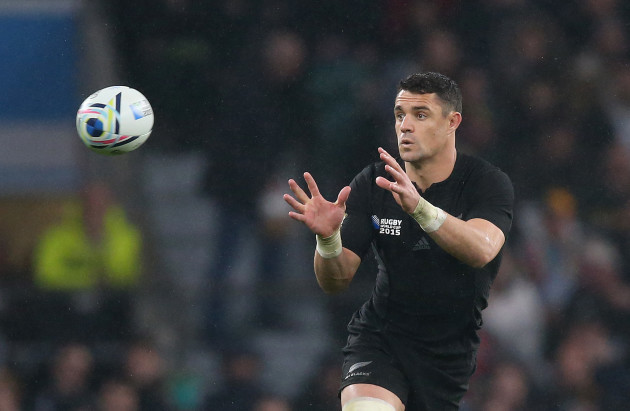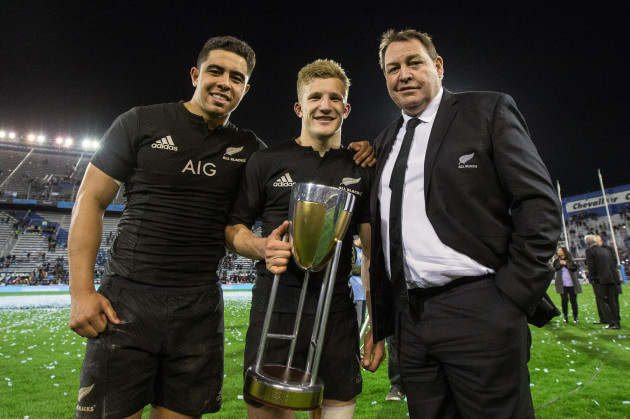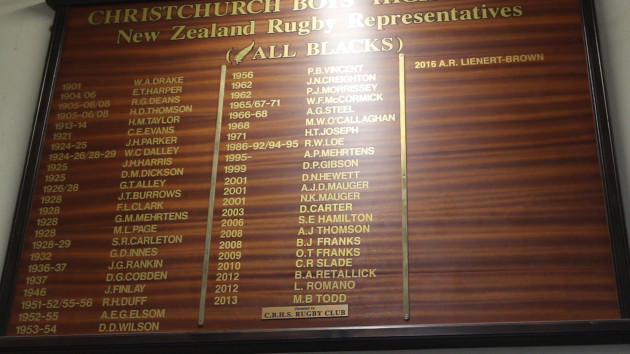This post is part of The42′s Facing History series, supported by Cadbury Boost. To read more, click here.
“A PLAYER CAN put on weight at the age of 19 if he needs to, but sometimes it’s too late at that stage to learn the skills.”
Rob Smith, rugby co-ordinator and part of the First XV coaching team at Christchurch Boys’ High School, pinpoints a major part of the philosophy that drives the school’s rugby programme, which has helped to produce 46 All Blacks.
Auckland Grammar, with 51, leads the way in terms of New Zealand’s secondary schools and the development of future All Blacks, but CBHS continues to punch above its weight.
Schoolboy rugby is one of the biggest factors in New Zealand’s ability to remain dominant at Test level, with this tier of the game bordering on professional.
Scouts from Super Rugby franchises, Australian rugby league clubs, and sometimes even the AFL track the most promising schoolboy talent. Games are screened live on television and thousands of supporters turn up to watch the biggest fixtures.
The Auckland 1A competition has the highest profile, stacked with ultra-dynamic Polynesian players as it is, but the state-run Christchurch Boys’ High is deservedly famous.
They have won three National First XV Championships, in 2004 [shared with Wesley College], 2005 and 2006 – an era of success that produced professional players such as Owen Franks, Colin Slade and Ireland international Rodney Ah You, among others.
This year, captain Ewan Milnes and his First XV team – the equivalent to a Senior Cup side in Ireland – won their regional competition, the University of Canterbury Championship, the school’s ninth such title in 16 years.
There was also a 16th consecutive win in the iconic derby clash with longstanding rivals Christ’s College, the private school just five minutes’ drive away.
In a school of 1,400 students, there are around 500 rugby players at Christchurch Boys’ High, which also excels in cricket and offers many other sports.
CBHS produces highly-intelligent rugby players. They have a reputation as a ‘first-five factory,’ with Dan Carter [who spent his final year of school there], Andrew Mehrtens, Slade, Aaron Mauger, and Japan internationals Kōsei Ono and Shaun Webb among the alumni.
Munster’s Tyler Bleyendaal, rated as one of the best, and New Zealand U20 international Josh McKay are among the more recent First XV out-halves, while 21-year-old Fletcher Smith has been impressing with Otago in the Mitre 10 Cup.
The great Graham Henry was also a first-five-eighth during his years at the school.
“We do try and challenge the boys tactically,” says master in charge of rugby, Phil Watson, who also teaches PE. ”We put the emphasis back on them, put them in situations and make them come up with the decisions and the answers, then give them feedback on it.
“I guess it’s about not being too robotic, it’s a case of them understanding what they need to do and making decisions on that. That’s an area I think New Zealand has a really big advantage.
“I’ve seen other international teams around the world and they do almost look robotic sometimes. The fact New Zealand can see what they’re doing, act on their feet and make their own decisions, I think that’s a really big point in why they’re so good at the game.”
The likes of Anton Lienert-Brown, Matt Todd and Brodie Retallick – all former CBHS students – are similarly intelligent players, and also possess outstanding skills.
At First XV level in CBHS, which also runs a fee-paying international rugby programme, there is detailed video analysis work done on both the opposition and their own games in order to aid the process of developing tactical understanding.
The fact that CBHS’ players generally tend to be smaller than the schoolboys from places like Auckland and Rotorua means they simply must make the best decisions possible.
“They learn to manage the game well, so they’re not reliant on size to try and smash through holes,” says First XV coach Danny Porte, an Englishman who was a professional player with Exeter and moved to New Zealand three years ago.
“They have to try and think their way around the pitch as well, which is one of the advantages when they push on and develop physically later. They’ve got that ability to read the game that others might not have.
“If you’ve been big enough to smash through people, you don’t really need to pick holes. Whereas our boys are probably looking for soft shoulders and getting the ball away more than others.”
There are 20 rugby teams in the school, catering for players of all abilities – even those who simply want to play a game at the weekend without the training load.
The First XV play mainly on Saturdays, with the rugby week including two squad training sessions on the pitch, one captain’s run, two gym sessions, and a Sunday recovery session in a local swimming pool.
“It’s a heavy schedule for an amateur player who’s got school commitments, family, maybe work commitments as well,” says Watson.
But there is no question about committing for these young men. A walk into the main school building and down a corridor filled with photos of legends, All Blacks jerseys, and the school caps worn by the likes of Carter and Mehrtens is enough to inspire.
“The boys see this every day,” says Smith – who played First XV rugby at the school during their run of national titles.
“They walk into this building that’s 135 years old, they’ve got these photos up of All Blacks and it breeds those high standards into them from the word go. There’s a photo of Fergie McCormick, Brodie Retallick’s jersey over there, Dan Carter. It’s pretty special.”
As in the rest of New Zealand, the development of basic skills is central to everything CBHS’ coaches do. Smith – who oversees the administration of the rugby programme – says they strive to have two coaches and one manager for every single team.
“Every session, you spend time on basic skills,” says Smith. “You break the season down, it might be that for a four-week block we want to really focus on our chop tackle.
“So we work really hard on our technique there, getting nice and low, our punch and wrap, then getting that first man there in support over the ball. We break down that skill and work on it repetitively for a four-week period for 10 or 15 minutes before training.”
With windows for individual skill work after each on-pitch training session too, no skill is neglected. Nothing is taken for granted.
“You’ve got to have good technique, first and foremost,” says Smith. “With the First XV this season, we went back to the old thing of setting your targets for catch-pass.
“We found a number of boys know how to catch-pass but come up and maybe get a bit lazy on it, so we’re really encouraging the boys to have their hands out and reaching for the ball, so they’re catching it out there [away from the body] and it’s gone in one movement.
“It’s breaking the skill down, revisiting stuff they did in U6, U8, U9 levels, and then putting them in an environment where they have defenders in their face and they’re doing it under pressure.
“You’ve got to be doing it repetitively and it becomes instinct under pressure.”
While the coaches at CBHS have a big focus on ensuring each session is fun, there is also a real desire on the players’ part to improve all the time.
“They understand that the First XV, with the profile it has, is like a shop window to their dreams,” says Porte, a science teacher. “We get boys year on year who sign contracts and go on to play professionally. The number of players who push on from here is incredible.”
And yet, Christchurch Boys’ High’s rugby programme is not just about the players who are going to move into the professional game.
Watson, who still plays with the local Shirley club and for the mid-Canterbury provincial side, stresses that everyone has an opportunity to play.
It is notable that Luke Romano, the All Blacks lock, was not a standout player in his time at the school, but he had a love for rugby that helped him continue to play the sport even after leaving CBHS.
“Some schools and programmes have quite an elitist slant on things and I think you’ve got to have a little bit of that but still giving everyone a go,” says Watson. ”It could be the U13B player or the First XV player, they’ve got to have an equal chance to play the game.
“We make sure they get enough coaching, enough game time, and get treated well. It doesn’t matter what team you’re in, you get equal opportunities to perform and achieve.”
While many of the 500 players in the school dream of being All Blacks, Watson says more young locals are realising that rugby is a fine way of making a living even if that highest level is out of reach.
“It is quite a realistic goal [playing for the All Blacks] and if it’s not, it could be to be a Crusader or an ITM Cup player, or just a professional athlete,” says Watson.
“That’s something we’re seeing more and more, that’s a pathway for them, it’s a career. Maybe a few years ago, that wasn’t an option. Now, being paid and being a professional player is a huge option.”
Christchurch Boys’ High is one of the many institutions, clubs and organisations which New Zealand rugby is built on – All Blacks coach Steve Hansen, a former centre, is another old boy – but they have their concerns about how sustainable their work is.
The school is made up entirely of students from within its ‘zone,’ locally-living boys. Being a public school, they cannot offer the scholarships that some of the wealthy schools up on the North Island do.
“I get worried that we will get left behind,” says Watson. “We’re a public school and our funding isn’t huge. We don’t give out scholarships, it’s the boys who come in the gate. We can’t target other individuals.
“I worry that other schools that have the resources to give out scholarships might start handpicking students, we might start losing students. I get worried that we will get left behind in that area.”
Smith points out that the school simply must keep doing what it’s been doing – producing All Blacks and young men who love rugby.
“The thing we have going for us is that boys want to come here and families want their kids to come here, because we have such a strong rugby history.
“We’re a traditional school with good morals and values. It’s up to us to make sure we maintain an environment that boys want to come here to be part of.”
- This article was updated at 7.45am on 18 October to amend an error stating that Kōsei Ono came to CBHS on the international rugby programme.
The42 is on Snapchat! Tap the button below on your phone to add!





